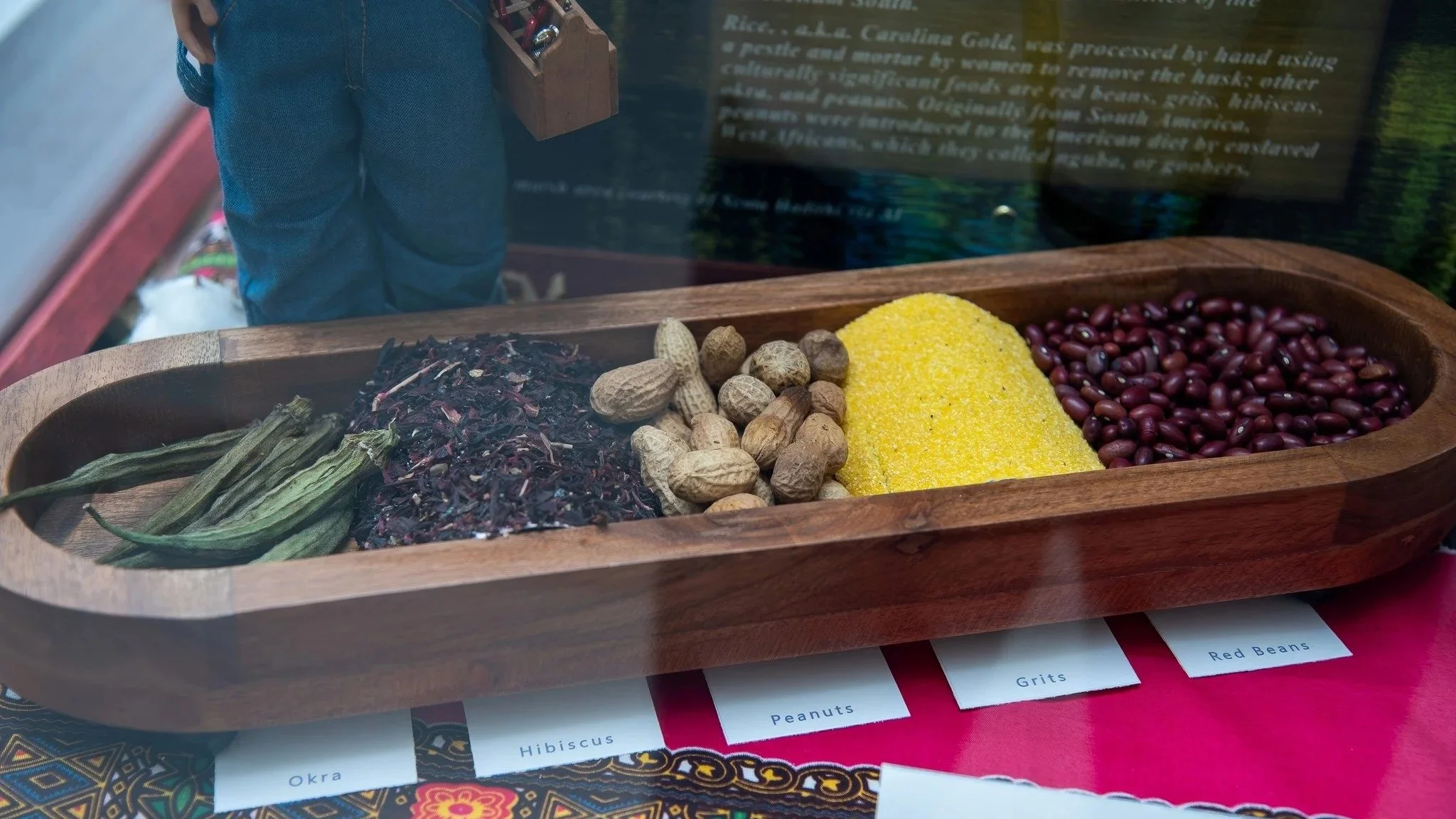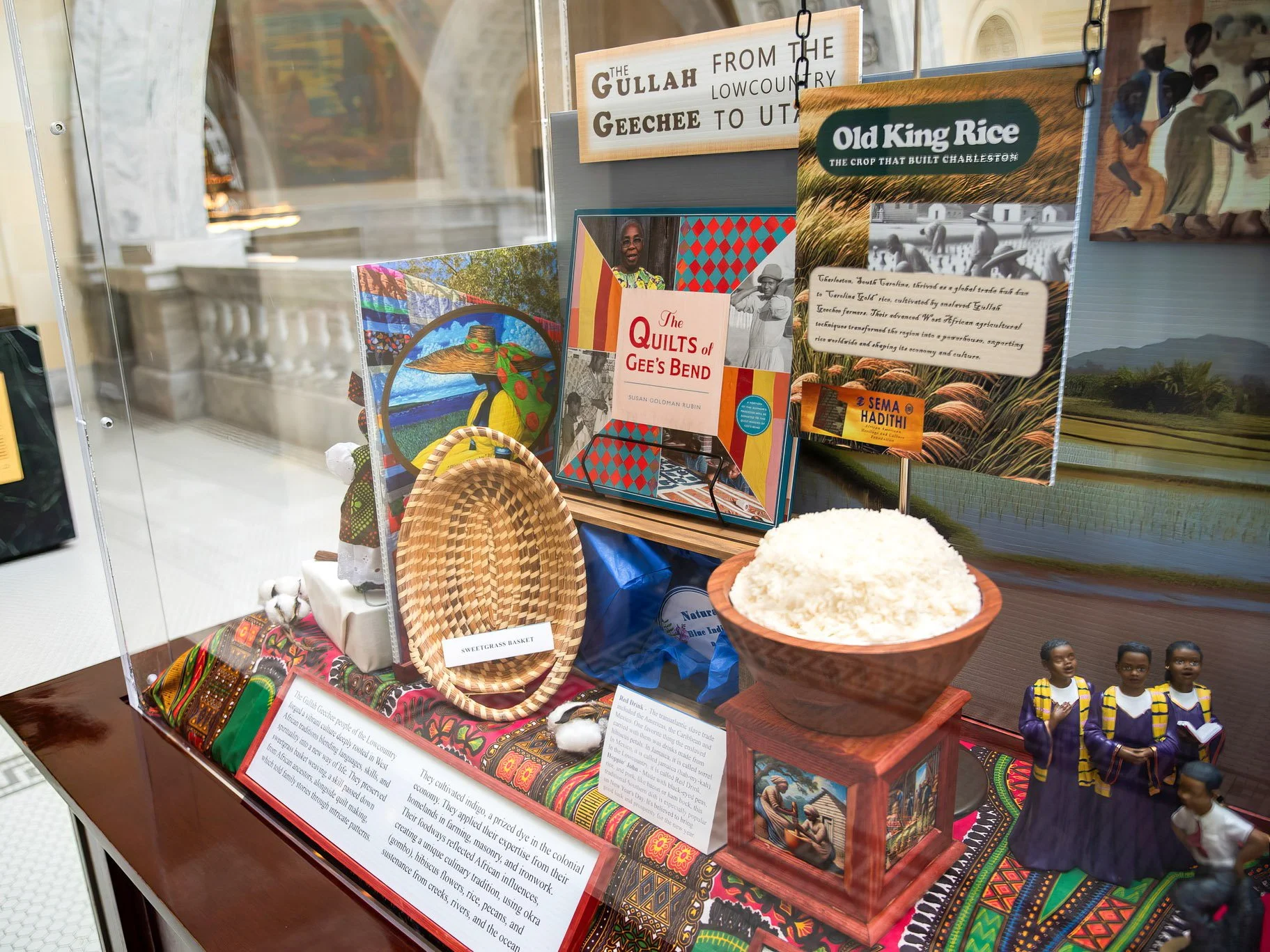
Visual storytelling delivers history like no other medium and exhibition is the best way we know how.
From the Lowcountry to Utah: A Charming Gullah Geechee Journey
It began with a sweetgrass basket.
Not just any basket, mind you—but one carefully hand-woven with strands of memory, tradition, and love. Its tightly coiled shape weaves the recollections of whispered stories that traveled across oceans and centuries, from the faded memories of the West African coast, to the salt marshes of the South Carolina coast, to the quiet halls of the Utah State Capitol.
Now, nestled in a glass case on the fourth floor of that Capitol building, this basket sits among an enchanting display called Gullah Geechee: From the Lowcountry to Utah. Visitors pause, lean in, and are transported—not just to another place, but to another rhythm. It is an African rhythm. One carried by ancestors who sang as they worked and prayed as they dreamed.
At first glance, it might look like a simple diorama—just tiny dolls, cloth, photos, and artifacts. But look closer. The little girl in the African dress, standing next to the rice mortar and pestle, seems to smile proudly. The man in overalls stands solid and rooted like a live oak, tools in hand. A schoolteacher doll with a book in her arms gazes forward as though ready to call the children in from recess.
It is more than a display. It is a world.
Photographs courtesy “Masons of High Marine” Facebook, Valdez Darris
The Humble Schoolhouse and the Ringing Bible
In one corner of the exhibit stands a small schoolhouse—a photo, a Bible, and a reader once used to teach children to read and write. The Bible wasn't just for worship. For many formerly enslaved Gullah Geechee people, it was the very first book they learned to read. Its familiar words offered both salvation and syllables.
Even now, visitors pause at the book, as if its verses still echo from the wooden benches of Lowcountry classrooms. You can almost hear the rhythmic voices of children repeating: "In the beginning... In the beginning... In the beginning…"
Here in Utah, surrounded by mountains instead of marshes, this tiny classroom feels like a sacred space.
Okra, Rice, and Red Drink
Then there is the food. The memory of it. The living tradition of it. A caldron of rice sits proudly on a pedestal, surrounded by okra pods and hibiscus blossoms—known to many as "red drink."
These are not just ingredients. They are passports.
Okra (or "gombo") is an essential condiment that connects directly to West Africa. Enslaved Africans perfected rice cultivation, a skill that was brought to the continent specifically for their expertise. Hibiscus tea still blooms in Gullah kitchens, tangy and bright as ever.
And in this display, the food does what it always has: it feeds the soul, even in miniature.
Indigo Hands and Quilted Stories
The dolls are dressed in fabric that shimmer with history—mudcloth, dyed with indigo, patterned with stories.
The Gullah Geechee people are masters of textiles, not only weavers of baskets, but of quilts—each rend of fabric a patch of memory: of suffering days in fields, of freedom walks, of grandmothers who hummed while stitching, of nights when stories were sewn by moonlight. The book about the artisans of Gee's Bend tells the story of quilts created as quiet flags of survival. Art pieces that embody resistance, faith, and beauty.
Some say fabric holds emotion. In this exhibit, it surely does.
Utah: A Surprise Chapter in the Story
Perhaps most surprising to visitors is the Utah section of the exhibit. What does this coastal culture have to do with the desert?
As it turns out—everything.
Some of the first settlers to enter the Salt Lake Valley were enslaved Africans from places like Mississippi.|
Three of the men in the Salt Lake Valley's first encampment were enslaved Africans.
Soldiers of the 9th and 24th regiments, known as the Buffalo Soldiers, were stationed in Utah. Some were Gullah Geechee, bringing with them not just military discipline, but music, language, and Lowcountry know-how. They patrolled Fort Douglas and walked the streets of Salt Lake City. They prayed in homes not far from the exhibit's walls. They left stories—some still waiting to be found.
In Ogden and Salt Lake City, porters and waiters formed churches, social clubs, and businesses. Their hands built communities. Their voices built choirs.
And now, their legacy builds bridges across time.
A World That Speaks Softly… but Deeply
The Gullah Geechee: From the Lowcountry to Utah exhibit may be small, but its heart is vast. Every piece was placed with care by Sema Hadithi African American Heritage and Culture, an organization committed to honoring and sharing Black history in Utah and beyond.
Children stand in front of the case, eyes wide. Elders lean in quietly. Some visitors smile; some wipe a tear. Everyone leaves carrying a little something with them—a whisper of a world that once seemed far away, but now feels close.
So, if you find yourself at the Capitol, ride the elevator to the fourth floor. Walk to the glass case. And let yourself be charmed by the songs, stitches, tools, and traditions of a people who brought the Lowcountry to Utah.
Exhibits “tell the story”
Rent this exhibit for you museum or community space
You can help us tell the story too.
Our newest exhibit now being prepared for you is “The Green Book and Other Black Travelers Guides”.
Please make a gift to help create them.









































